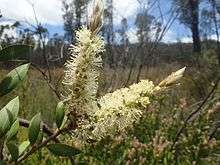Melaleuca pallida
| Lemon bottlebrush | |
|---|---|
 | |
| Melaleuca pallida leaves and flowers | |
| Scientific classification | |
| Kingdom: | Plantae |
| (unranked): | Angiosperms |
| (unranked): | Eudicots |
| (unranked): | Rosids |
| Order: | Myrtales |
| Family: | Myrtaceae |
| Genus: | Melaleuca |
| Species: | M. pallida |
| Binomial name | |
| Melaleuca pallida (Bonpl.) Craven | |
| Synonyms | |
Melaleuca pallida, commonly known as lemon bottlebrush, is a plant in the myrtle family, Myrtaceae and is endemic to eastern Australia. (Some Australian state herbaria use the name Callistemon pallidus.)[1] It is an upright shrub with thin, spreading branches, silvery new growth and pale yellow, sometimes pinkish bottlebrush flowers.
Description
Melaleuca pallida is a shrub or tree growing to 8 m (30 ft) tall, with fibrous or papery bark. Its leaves are arranged alternately and are 20–79 mm (0.8–3 in) long, 4–17 mm (0.2–0.7 in) wide, flat or broadly v-shaped, narrow elliptic to egg-shaped with the narrow end towards the base and with a small point at the end. There is a distinct mid-vein, 6-16 indistinct side veins and many distinct oil glands.[2][3][4]
The flowers are a shade of cream to yellow, occasionally pinkish-red and are arranged in spikes on the ends of branches which continue to grow after flowering and sometimes also on the sides of the branches. The spikes are 20–45 mm (0.8–2 in) in diameter with 15 to 50 individual flowers. The petals are 2.9–6 mm (0.1–0.2 in) long and fall off as the flower ages and there are 34-70 stamens in each flower. Flowering occurs from October to February and is followed by fruit which are woody, cup-shaped capsules, 3.9–6.6 mm (0.2–0.3 in) long.[2][3][4]
.jpg)
Taxonomy and naming
Melaleuca pallida was first formally described in 2006 by Lyndley Craven in Novon.[5][6] The specific epithet (pallida) is a Latin word meaning “pale”[7] referring to the pale flower colour.[2]
Distribution and habitat
Melaleuca pallida occurs from the Border Ranges area in far south eastern Queensland, through the ranges and slopes of New South Wales to eastern Victoria. It is also present in all but the far west of Tasmania and on some Bass Strait islands.[2][3] It grows in streams and wet, rocky slopes.[2][3]
Use in horticulture
Melaleuca pallida is sometimes cultivated as Callistemon pallidus. It is a hardy plant, adaptable to many soils but needs full sun.[8]
Gallery
-
M. pallida in the in the Munich Botanic Garden as Callistemon pallidus
-

M. pallida leaves and fruit
-
.jpg)
M. pallida growing near wet heath in the Gibraltar Range
References
- ↑ Udovicic, Frank; Spencer, Roger (2012). "New combinations in Callistemon (Myrtaceae)" (PDF). Muelleria. 30 (1): 23–25. Retrieved 11 June 2015.
- 1 2 3 4 5 Brophy, Joseph J.; Craven, Lyndley A.; Doran, John C. (2013). Melaleucas : their botany, essential oils and uses. Canberra: Australian Centre for International Agricultural Research. p. 266. ISBN 9781922137517.
- 1 2 3 4 Spencer, Roger; Lumley, Peter F. "Callistemon pallidus". Royal Botanic Garden Sydney: Plantnet. Retrieved 15 July 2015.
- 1 2 Mullins, Effie. "Callistemon pallidus". Australian National Botanic Garden. Retrieved 15 July 2015.
- ↑ "Melaleuca pallida". APNI. Retrieved 15 July 2015.
- ↑ Craven, Lyn A. (2006). "New Combinations in Melaleuca for Australian Species of Callistemon (Myrtaceae)". Novon. 16 (4): 472. doi:10.3417/1055-3177(2006)16[468:NCIMFA]2.0.CO;2. Retrieved 15 July 2015.
- ↑ Brown, Roland Wilbur (1956). The Composition of Scientific Words. Washington, D.C.: Smithsonian Institution Press. p. 584.
- ↑ Wrigley, John W.; Fagg, Murray (1983). Australian native plants : a manual for their propagation, cultivation and use in landscaping (2nd ed.). Sydney: Collins. p. 193. ISBN 0002165759.